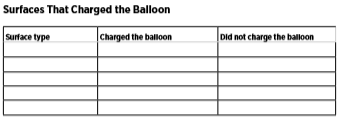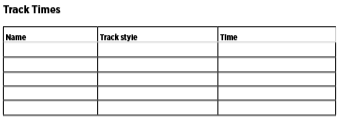
Teaching science when you don't know diddly squat: Can you move something with static electricity?
DOWNLOADJune 18, 2019 - Michigan State University Extension
Purpose:
The purpose is not to teach specific content, but to teach the process of science – asking questions and discovering answers. This activity encourages young people to try to figure things out for themselves rather than just read an answer on the internet or in a book. As a leader, try not to express your opinion, but let the youth engage in arguments based on evidence.
Time required:
20 minutes or multiple days depending on the interest and questions the youth have
Materials:
- Piece of fake or real fur or hair
- Balloon (one for each participant and a couple extras)
- Small pieces of paper or hole-punch dots
- Paper (one sheet for each participant)
- Writing utensils (one for each participant)
- 2-4 clean, empty aluminum cans
- Stopwatch (optional)
Science Practice:
Asking questions and defining problems
1. Do you think you can move objects using static electricity? What is static electricity?
Science Practice:
Planning and carrying out investigations
2. Have each youth blow up and tie of a balloon, then rub it on various surfaces trying to build up an electrical charge. Have each test the balloon by moving it over the pieces of paper but not touching them. If the paper pieces jump to the balloon that means the balloon is charged with static electricity. What did you discover about the types of surfaces that charge your balloon? Did different surfaces work better than others?
Science Practice:
Using mathematics and computational thinking
3. Have each participant create a chart to record the surfaces they tried.

Science Practice:
Planning and carrying out investigations
4. What do you think will happen when you place your balloon next to an empty aluminum can lying on its side? Try it. Why did that happen?
5. After youth charge the balloons, have them try to use theirs to roll an empty aluminum can without touching it. Have the youth use their charged balloons to complete can races. Begin with a straight track, then let the youth design a course to race their cans through. Make a chart to record times and track styles.

Science Practice:
Analyzing and interpreting data
6. What did you discover when you raced your can? Did the distance or angle you held your balloon to the can make a difference? Did the size of the balloon make a difference? Does the color of the balloon make a difference?of the balloon make a difference? Does the color of the balloon make a difference?
Science Practice:
Constructing explanations and designing solutions
7. Based on what you observed, how could you make your can move faster? Easier to control?
Science Practice:
Engaging in argument from evidence
8. Which surface charged your balloon so the can moved the fastest? Which surface charged your balloon so it was the easiest to control? Were they the same surface? Why do you think that surface worked the best?
Science Practice:
Obtaining, evaluating, and communicating information
9. Can you think of any situations in which knowing which surfaces create static charges would be useful? Can you think of times you have experienced static electricity? What were you doing? Where were you? What were you wearing? What time of year was it? What was the weather like?
Other thoughts:
- Do you think there are other objects that would hold a static charge like a balloon?
- Try using the charged balloon to move other objects
Science & Engineering practices:
These eight Science and Engineering Practices come from A Framework for K–12 Science Education (National Research Council, 2012, p. 42). These research-based best practices for engaging youth in science are connected to in-school science standards that all children must meet
- Asking questions and defining problems
- Developing and using models
- Planning and carrying out investigations
- Analyzing and interpreting data
- Using mathematics and computational thinking
- Constructing explanations and designing solutions
- Engaging in argument from evidence
- Obtaining, evaluating, and communicating information
Reference:
National Research Council. (2012). A framework for K-12 science education: Practices, crosscutting concepts, and core ideas. Washington, DC: National Academies Press.



 Print
Print Email
Email




